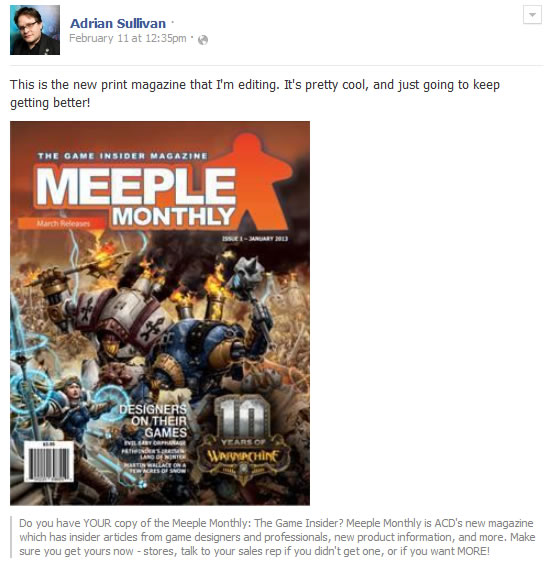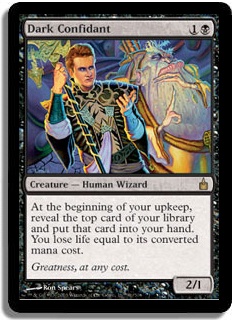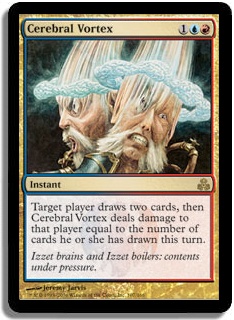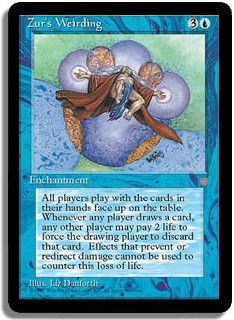It’s been a while. A long while.
Over the last few months, I’ve had a lot of people ask me when I’d be doing some writing again, and the answer has basically been the same: I don’t know.
Taking a cue from Cedric Phillips, there is, perhaps, a little bit of a story in all of this.
As most of you probably know, I do commentary for SCGLive. What most of you probably don’t know is that I have a day job in the gaming industry, too. I’m fortunate enough to work for Bob Maher at ACD Distribution, a hobby gaming distribution company. What does that mean? Well, ACD buys games from game companies (like Wizards of the Coast) and sells them to stores (like StarCityGames.com). I’m still in my first year with the company, working as their director of communications, and I’m pretty excited about having a permanent gig with a gaming company.
What on earth is it that I do?
Well, I edit a magazine on gaming, Meeple Monthly, that our company puts out. I make demo videos. In my job, I end up speaking with a lot of game companies and game designers and do other cool stuff.

That’s the kind of cool stuff that I’m doing.
But unfortunately it means that I’ve often just not had the time to make sure that I’m getting the writing done that I’ve been doing for, at this point, over fifteen years. Well, I’m really lucky that my boss is a Magic player, because I spoke with Maher about how I’ve been missing out on writing as much as I liked and he said it was cool with him if I scratched out a little time to do it.
Thanks, Boss!
SCG Open Series: Milwaukee
This was an event I had been looking forward to with gusto. Milwaukee Magic is some of the most gung ho Magic you’ll ever see, and there are few communities anywhere that give a damn about city pride like Milwaukee. The biggest Milwaukeean in attendance was probably Owen Turtenwald, who despite it being his birthday weekend had a lot more fun out in the world with friends than he did with his tournament results.
There were plenty of others to be found, though, and at one point I counted seven Wisconsin State Champions in attendance. It was pretty cool, especially seeing some of the really old school faces—people like Dominic Reisland, who has done his fair share of writing but was also the person who uncovered the so-called "Waylay Trick" from tournament Magic about fifteen years ago. My favorite face of the weekend was probably Rob Castro, Wisconsin’s first Magic State Champ, who woke up too late to play in the Standard but ended up having a great time all weekend anyway.
As for the tournament itself, leading into it I’d been playing a lot of Standard and Legacy, though certainly more Standard, and coming into this event I was pretty excited about what was possible.
In Standard, I had a conundrum: I had a beatdown deck I liked, sure, but I also had a control deck that I’d been working on that I knew was powerful. But one thing I knew was that there were some small details that weren’t ready—I’m just a huge fan of an incredible amount of testing, and I hadn’t quite gotten there with the control deck. I’d made a USA deck with black (I’d been jokingly calling it "Obama’s America") that I gave to Jackie Lee, and she had had some minor success with it, cashing at an event with it.
Creatures (3)
Planeswalkers (3)
Lands (25)
Spells (29)

The deck was good, certainly, but it had some problems I’d become uncomfortable with. The mana was surprisingly good. It just seemed at times to be underwhelming when it came to finishing the game, though, and I wasn’t sold on the idea that this was a four-counterspell format. Frustratingly, against control, one of the major paths to victory, Lone Revenant, also left you vulnerable to mass removal. How to solve the problem? Furthermore, a new set had been released, and surely the mana could be made a little better. Right?
After watching the card in a ton of matches for SCGLive, I decided to try an experiment with Assemble the Legion, and from there, the deck just kept shifting until I got to this point:
Creatures (9)
Lands (25)
Spells (26)

I was moderately happy with how the deck was put together, but things didn’t turn out so well. A large part of it was that the mana wasn’t fully honed, and there were more than a few turns where I found myself just a step behind because of how my mana was playing out. Compare this to how it felt with the previous mana configuration which Jackie had called "practically perfect." Somewhere around 3-3 I dropped and moved on to the Legacy portion.
Now in Legacy, I knew exactly what I wanted to play: U/R Delver (or U/R Burn, if you prefer). That desire was solidified during this match:
Terrell went on to lose this match, but one of the things that struck me about it in particular was that he was essentially very much in this match despite making a number of decisions that I didn’t feel were particularly savvy to the High Tide matchup.
Creatures (15)
Lands (18)
Spells (27)

I put a version of the deck together, started slinging it whenever I could, and didn’t look back.
Ultimately, there were a couple of cards that I just didn’t really care for: Vapor Snag. I did a ton of research on other people’s decklists, decided to make adjustments to the land that suited my experience thus far, and came to a 59-card decklist in need of a single spell. I did some research and almost ended up choosing a Fireblast (a la Glenn Jones) for my 60th card, but instead I ended up with something a little different:
Creatures (15)
Lands (19)
Spells (26)

Of all of the cards in my maindeck, the one that is sure to get some looks is this one:
This is definitely a one-of, no more, should you choose to run it. I decided to use it for a few reasons that all tie together. Sometimes, you just need a little more gas. A Ponder, as good as it is, doesn’t help you fill up the tank. In those matchups where you need gas, it is a pretty good way to go. Importantly, though, sometimes you can just dome out an opponent, particularly if they are combo. A draw phase plus a Brainstorm or Jace activation is four cards drawn, so a Cerebral Vortex can do the final six damage if it isn’t stopped.
All weekend, I was incredibly happy with the card and will be happy to resleeve it up as soon as I can.
The other card that got a lot of notice is this one:
Now, if you look at the original version of the card, it isn’t a very good description of what the card does. The current oracle text is a bit more useful:
3U, Enchantment
Players play with their hands revealed.
If a player would draw a card, he or she reveals it instead. Then any other player may pay 2 life. If a player does, put that card into its owner’s graveyard. Otherwise, that player draws a card.
What on earth is that for?
One of the things that I discovered in testing Modern was that combo simply cannot beat that card in any reasonable way. It is against allcombo essentially a lights out, with only a single card—the new Yawgmoth’s Will, Past in Flames—able to escape its clutches. They have to have everything in their hand or they are done.
Perhaps the best deckbuilding choice, though, came from Patrick Sullivan, who kindly replaced these:
with
Thanks, Patrick, for the extra technology!
Some of you may gawk at the Threads of Disloyalty, but more on that below.
As a non-tournament report goes, here are the results:
Round 1 – BUG Delver, L 0-2; This was just a good match that they took down.
Round 2 – Jund, W 2-1; Price of Progress and Threads were great.
Round 3 – Enchantress, W 2-0
Round 4 – RUG Delver, W 2-1; Price took game 1, and Threads took game 3.
Round 5 – TES (by Tommy Kolowith), W 2-1; Zur’s Weirding FTW.
Round 6 – U/B Control (by Caleb Durward), W 2-1; Vortex took game 3.
Round 7 – RUG Delver, L 1-2; Nimble Mongoose was a problem (more below).
Round 8 – Esper Stoneblade, W 2-1; Barely won a close match.
Round 9 – Shardless Agent, L 0-2; I came to play. :)
Nine rounds, eight different matchups. Typical Legacy—I love it!
This finish was sufficient for me to Top 32, just by the skin of my teeth, but it did have me thinking, "What could I have done to do better?"
In rounds 4 and 7, I played against RUG Delver, and a part of the plan in this matchup was to use Threads as a means to fight against Tarmogoyf. In this, the plan was great, but some things just go awry at times. You’ll see what I mean in the feature match versus Neil Milligan:
Maybe you were too busy noticing my sleeves not having any glare to see what happened. What went wrong is simple: he never dropped Tarmogoyf, and I just got eaten alive by Nimble Mongoose.
In thinking about it, one of the things that actually seemed somewhat clear is that if my opponent had simply sided out the Tarmogoyfs, I may have been in a similar kind of trouble as I was in this match where he simply didn’t draw them.
Another thing that seemed abundantly the case all day too was that even if I did Threads a Tarmogoyf (which I did a few times), all it would take is a Red Elemental Blast or Pyroblast to ruin my day. This seemed like a problem.
And still, there was no clear answer to Nimble Mongoose.
The issue is actually pretty simple: Tarmogoyf by itself is a big enough threat that you don’t actually want to side out all of your Force of Wills simply so you can potentially keep one off of the table. Unlike other RUG Delver decks, U/R Delver doesn’t have the Tarmogoyf of its own to help keep things more reasonable. One potential solution to this is to simply add those Tarmogoyfs, but the question you are basically asking yourself is one of Price of Progress versus Tarmogoyf. This is a harder question than many realize. Right now, in this current moment, I know I prefer Price.
So back to the problem of Nimble Mongoose (and its less problematic friend, Tarmogoyf). These cards don’t just exist in and of themselves, either—any solution you care to find really does have to take the other into account.
Now, one solution is something that I spent some time talking with Patrick Sullivan and Glenn Jones about the Friday before the event: Lava Spike. Here, the plan is to turn slightly more into a burn deck and just kill them before they get anything rolling. Maybe this is the most elegant solution actually. It does mean, though, that you want to keep in all of your short-term damage cards like Goblin Guide.
Yes, I did utterly murder Neil in game 1 on the back of three Goblin Guides by turn 2, but that is not the way that you can expect your draws to typically work themselves out. Goblin Guide is an utter nightmare against a deck that can block, Brainstorm, and burn.
Another solution, cooked up by my friend Brian Kowal, was to find a way to fit in Mishra’s Factory. This one has a lot of intrigue for me as long as we are treating our Mishra’s Factorys like spells rather than land. A Factory all by itself can eat a ‘Goose, and with a friend it can attack into a Goose. This just might be the solution I’m looking for, but I’m not certain.
One idea I had was Phantasmal Image, which could come down as a ‘Goose of my own and either trade or race. This doesn’t seem like a bad call, particularly because it can in a pinch make a copy (albeit a fragile one) of a flipped Delver or a Tarmogoyf. In addition, it has the added bonus of being a legend killer, which is always a nice plus.
Another thing I considered was Relic of Progenitus, but I have misgivings about a card that hurts my Snapcaster Mages and Grim Lavamancers even if it has an effective ability in other matches as well.
Finally, another solution is to find some kind of other creature that I haven’t yet considered that might be able to be a solid fit against Nimble Mongoose. I’m still hunting.
What I’m not looking for are cards that stretch out my colors like Rest in Peace. One thing I don’t want to have in a deck like this is The Fear.
Still, as spoiler season ticks down, I know where I’m at with Legacy—I’m definitely still high on U/R Delver. I think the deck is excellent right now. It has two elements going on at once: the power of its blue core of Brainstorm, Ponder, Snapcaster Mage, Delver, and free/cheap countermagic combined with the reach and finality of burn. This deck feels incredibly more forgiving than most, and it has the ability to steal games away from players because of Price of Progress.
This weekend, I’ll be down in Bloomington, IL at Gryfalia’s Aerie gunslinging in the Prerelease on Saturday. I’ll be armed with U/R Delver, Standard, Modern, and, of course, Simic/Izzet. I hope I see you there.
Still, though, I’m wondering if I’m missing a card I should be thinking about to solve the RUG problem. If you have already found the solution, I’m certainly all ears. Aside from here, I can always be found at my Facebook page, so feel free to hit me up if you’ve definitively solved the ‘Goose problem.





